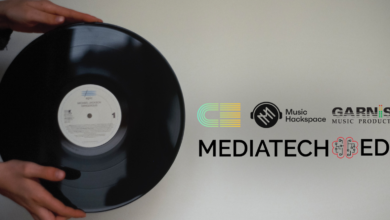Learning Online; Streaming Media Technology in Education

School is back though if you’re in the same situation as most of us, we’re not actually “back,” we’re home, but back.
My house has 3 on zoom calls throughout the day and my wife, working for the middle school, means our Internet Service Provider is drafting up a white paper about how it can manage 5 people in one home livestreaming at the same time (all while Amazon Alexa plays Hamilton’s You’ll Be Back on repeat for me)
We can watch Jonathan Groff spit at us 2,790,601 times not only because it’s a great song and he gives an incredible performance but because it looks good. It sounds good.
Teachers, stuck on video calls all day, this production quality matters and it’s not that difficult nor expensive to put in place.
Teaching from Home with a Studio
Trent Thurman, the University of Texas’ Director of the Master of Science in Technology Commercialization (MSTC) program at the McCombs School of Business and a management lecturer, shared this photo of his setup and it dawned that we all, teachers and working professionals alike, can help us through this online and virtual experience with just a little investment in a home (or office) studio.
“Camera is Logitech C922 Pro Stream (1080p makes a huge difference), small ring light is from Amada. I got it because it has a gooseneck arm that also has a webcam mount for Logitech camera, mic is from Castries, easy plug and play that had good reviews on Amazon and wasn’t terribly expensive, and the monitor is a 32 in/1080p from ViewSonic. Makes a huge difference in gauging student reaction on Zoom!

Chris Hayhurst with CDW‘s family of technology magazines and a writer for EdTech, spoke with Justin Harding, senior director for instructional design and new media for Arizona State University’s EdPlus program.
“Harding and his colleagues produced a catalog of webinars “on everything from ‘this is how you Zoom’ to how to create active-learning experiences in the online space,” he says. Instructors were taught how to use ASU’s learning management system to communicate course announcements, assignments and exams, and they were introduced to platforms like Slack, where instant messaging and content sharing could substitute for in-person discussions. Within days, subjects as varied as computer science and ornithology, previously taught through lectures and labs, were being delivered using digital tools, and students in need had their pick of critical resources, from laptops and hotspots to free digital textbooks.”
And why is this investment so critical? Because being on the receiving end of staring a computer screen and livestream is straining.
Take a look at this as I poke a bit of fun at myself before we dive into some practical suggestions…
I spoke recently with mediaspace.global‘s Lavina Suthenthiran about GovTech and regulation in media, but it’s not the topic that I want you to listen in on, it’s my own oversight in streaming from home.
Now, I sound great (granted, I think), but I don’t look so hot do I? And I’m not talking about my mid-life receding hairline. My lighting is bad and can you imagine watching me teach for hours a day with that glare on my glasses?
Here’s what I have that works well:
- RODE Podmic
- Audio-technica ATH-M40x headphones
- Focusride Scarlett 2i2 usb Audio Interface (which connects that mic to my laptop)
For a few hundred bucks, you sound wonderful. I’m shopping this afternoon for that better camera and lighting.
Best Practice Teaching or Speaking from a Home Studio
The University of Minnesota put together a really nice synopsis on how to be prepared to Zoom:
- Decide whether you will use one monitor or two monitors
- It’s a really good idea to use two so you can see your notes or curriculum in one screen while looking to your class in and the stream in another.
- Get a headset and microphone to reduce background noise
- Check! And I’m looking into Trent’s camera and lighting setup.
- Test your audio and video
- Review how to share your screen
- Close unnecessary tabs in your browser and turn off notifications such as Email or messaging
- Trust me, that message will pop up at the least opportune time.
- Lighting should come from in front of you or from the side, in order to best light your face
- Keep your background clear of distractions
- Look at your webcam, not at the screen
- Use gestures and mannerisms that you would typically use in person
- You’re not on the 5 o’clock news being interviewed, you’re in class, but not.
In particularly, make sure you look at what it takes to secure your classroom environment and keep an eye out for unexpected guests. It’s unfortunate but some headlines have been made about what are being referred to as Zoom Bombs whereby some very unfortunate material takes over your video. Here’s the University of Minnesota’s guide to that.
Dan Benjamin has a wonderful video about how to sound great on the air and recommends the following setup:
- Shure SM7b mic
- AUPHONIX Pop Filter
- Heil Sound PL-2T Overhead Broadcast Boom (which is that arm Trent mentioned that holds the mic; I have the same)
How to Look Good on a Livestream
What works best is what’s known as a 3 Point Lighting System (which really just means 3 lights). A “KEY” light is the main light and should be at a 45 degree angle facing you (imagine it beyond your laptop and off to the right between 1 and 2 on the clock face). A “hair” light reduces shadows by being to your left but also angled (image it at about 9 on the clock face but pointed to you at 45 degrees as well, toward your back). Finally, there is what’s referred to as a “RIM” light which comes from behind and helps you stand out from the background (this is as 5 on the clock and pointed 45 degrees toward you).
Certainly, most of us aren’t likely to actually have three lights but I wanted to let you know how the pros do it. Trent is working with one and those ring lights you can find on Amazon are great. What you might try, because this also can look really nice, is just using the daylight from a window as that KEY light (face the window, never put it behind you, at a 45 degree angle).
John Zozzaro just had a wonderful chat with Lani Rosales of The American Genius and you can see the difference in the attention to lighting and camera quality.
Of course, a great challenge for our teachers is that this is an investment. You’re in for at least maybe $300 to have a decent home studio from which to teach.
Our teachers and administrators throughout the world, particularly in public schools, have pulled of an incredible challenge of pivoting and preparing to teach millions of students at home, online, instead of in class, and one of the greatest investments you might make for your teachers, is a bit of this equipment to help them look and sound good as they endeavor to keep those kids’ attention.
All those links above are worth a look or reach out and let us know if we can help you figure this stuff out. Be sure to also subscribe to our newsletter because each week, Ted Cohen takes a closer look at innovations in media with reviews of some of the newest technologies; he’ll keep an eye out for you, for some of those media innovations that should get your attention.








Thank you, Paul! Great article and solid tips!!!